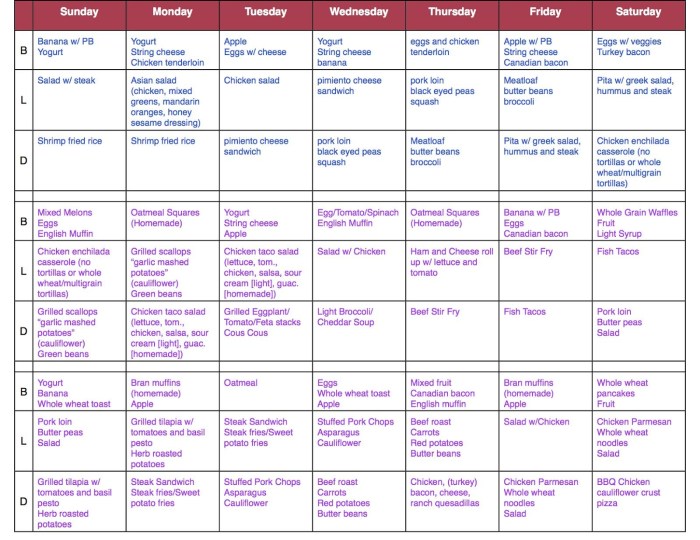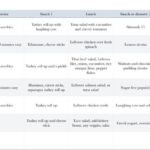South Beach Diet Phase 1 Chili: Craving a hearty, flavorful meal that aligns perfectly with the restrictive yet rewarding first phase of the South Beach Diet? Look no further. This recipe delivers a satisfying chili packed with deliciousness, all while adhering strictly to Phase 1 guidelines. We’ll explore the core principles of Phase 1, delve into the recipe’s nutritional benefits, and offer creative serving suggestions to keep your meals exciting and your weight loss journey on track.
Get ready to enjoy a chili that’s both healthy and incredibly tasty.
This comprehensive guide walks you through creating a South Beach Diet-compliant chili, providing a detailed recipe, ingredient alternatives, and tips for maximizing flavor without compromising your dietary goals. We’ll cover everything from choosing the right cooking methods to exploring creative serving suggestions and variations to suit your preferences. Whether you’re a seasoned South Beach dieter or just starting out, this chili recipe is a game-changer.
Chili Recipe Adaptation for Phase 1

The South Beach Diet Phase 1 emphasizes low-carbohydrate, high-protein intake to jumpstart weight loss. Adapting a beloved recipe like chili requires careful consideration of ingredient choices to ensure it aligns with these restrictions. This recipe focuses on maximizing flavor while minimizing carbohydrates and adhering strictly to Phase 1 guidelines.
Phase 1 Compliant Chili Recipe
This recipe serves 4-6 people and prioritizes lean protein sources and low-carbohydrate vegetables. Ingredients:* 1 lb lean ground beef (or turkey, chicken, or a plant-based substitute like Beyond Meat)
- 1 large onion, chopped
- 2 cloves garlic, minced
- 1 green bell pepper, chopped (optional, as some may find it too high in carbohydrates for Phase 1)
- 1 (28 ounce) can crushed tomatoes
- 1 (15 ounce) can tomato sauce
- 1 (15 ounce) can diced tomatoes, undrained
- 1 tablespoon chili powder
- 1 teaspoon cumin
- 1/2 teaspoon oregano
- 1/4 teaspoon cayenne pepper (optional, for heat)
- 1 teaspoon salt
- 1/2 teaspoon black pepper
- 1 cup beef broth (low-sodium)
- 1/2 cup chopped cilantro (optional, for garnish)
Instructions:
- Brown the ground meat in a large pot or Dutch oven over medium-high heat. Drain off any excess fat.
- Add the onion and bell pepper (if using) and cook until softened, about 5 minutes.
- Stir in the garlic and cook for 1 minute more.
- Add the crushed tomatoes, tomato sauce, diced tomatoes, chili powder, cumin, oregano, cayenne pepper (if using), salt, and pepper.
- Stir in the beef broth.
- Bring the chili to a boil, then reduce heat and simmer for at least 30 minutes, or up to 2 hours for a richer flavor. The longer it simmers, the more the flavors meld.
- Garnish with cilantro before serving.
Alternative Ingredient Suggestions
For those with allergies or preferences, several substitutions can be made while maintaining Phase 1 compliance.* Ground Meat Alternatives: Ground turkey or chicken are excellent leaner alternatives to ground beef. For vegetarians or vegans, plant-based ground meat substitutes can be used, but be sure to check the carbohydrate content as it can vary widely.
Spice Adjustments
Reduce or eliminate cayenne pepper if you prefer a milder chili. Experiment with other spices like smoked paprika or chipotle powder for different flavor profiles.
Vegetable Substitutions
If green bell peppers are too high in carbohydrates for your Phase 1 needs, omit them entirely. The flavor of the chili will still be excellent.
Nutritional Benefits of Phase 1 Adapted Chili
This chili recipe is a rich source of protein, supporting muscle maintenance and satiety, crucial for weight loss. The tomatoes provide lycopene, a powerful antioxidant. The spices offer anti-inflammatory benefits. By limiting carbohydrates, this recipe helps to control blood sugar levels and promotes ketosis, a metabolic state that facilitates fat burning. The fiber content, while moderate, contributes to digestive health.
Nutritional Comparison: Phase 1 Chili vs. Standard Chili
The following table compares the approximate nutritional content per serving (assuming 6 servings) of this Phase 1 compliant chili and a standard chili recipe containing beans and higher carbohydrate vegetables. These are estimates and can vary depending on specific ingredients and brands used.
| Nutrient | Phase 1 Chili | Standard Chili |
|---|---|---|
| Calories | 250-300 | 350-450 |
| Protein (grams) | 25-30 | 15-20 |
| Carbohydrates (grams) | 10-15 | 40-50 |
| Fat (grams) | 15-20 | 20-25 |
Cooking Methods and Techniques: South Beach Diet Phase 1 Chili

Preparing a delicious and healthy Phase 1 South Beach Diet chili requires careful consideration of cooking methods and techniques. Prioritizing low-fat cooking methods is crucial to staying within the dietary guidelines, while simultaneously maximizing flavor. This section details optimal approaches to ensure your chili is both satisfying and compliant.
The South Beach Diet Phase 1 emphasizes lean protein and plenty of non-starchy vegetables. Therefore, cooking methods that preserve nutrients and minimize added fat are paramount. Methods like braising, simmering, and slow cooking are ideal for developing deep flavors in your chili without resorting to high-fat options.
Suitable Cooking Methods for Phase 1 Chili
Several cooking methods are perfectly suited for preparing a Phase 1 compliant chili. Each method offers unique advantages in terms of flavor development and nutrient retention. Choosing the right method depends on your available time and preferred texture.
- Simmering: This gentle cooking method involves bringing the chili to a near boil, then reducing the heat to maintain a low, steady simmer. Simmering allows the flavors to meld gradually, creating a rich and complex chili. A picture would show a pot of chili gently bubbling on a stovetop, the steam rising subtly, indicating a low simmer.
The chili’s ingredients are clearly visible, showing a mixture of lean meats and colorful vegetables.
- Slow Cooking: Slow cookers are perfect for developing deep, intense flavors. The low and slow cooking process allows the chili’s ingredients to break down and meld together, resulting in a tender and flavorful final product. Imagine an image showcasing a slow cooker filled with a hearty chili, its aroma subtly escaping the lid. The chili appears thick and rich, suggesting hours of slow cooking.
- Braising: Braising involves initially searing the meat (optional, but adds depth of flavor) before simmering it in liquid. This method is ideal for tougher cuts of meat, which become incredibly tender during the long cooking time. A visual representation would depict a browned piece of lean beef in a pot, surrounded by simmering broth and vegetables, ready to be braised slowly.
Step-by-Step Chili Preparation, South Beach Diet Phase 1 Chili
The following steps Artikel the preparation of a Phase 1 compliant chili. Precise measurements are provided to ensure adherence to the dietary guidelines. Remember to adjust spice levels to your preference.
- Sauté Aromatics (10 minutes): Finely chop one medium onion and two cloves of garlic. Sauté in a large pot with 1 tablespoon of olive oil until softened. A picture would show a pan with glistening olive oil, the onions and garlic translucent and fragrant.
- Brown Lean Meat (15 minutes): Add 1 pound of lean ground turkey or beef. Brown the meat, breaking it up with a spoon. The image would show the ground meat browning nicely in the pan, with some visible browning and rendered fat being released.
- Add Vegetables and Spices (5 minutes): Stir in 1 (28-ounce) can of diced tomatoes (undrained), 1 (15-ounce) can of kidney beans (rinsed and drained), 1 green bell pepper (chopped), 1 red bell pepper (chopped), 1 teaspoon of chili powder, 1/2 teaspoon of cumin, and salt and pepper to taste. A picture would show the pot filled with a colorful mixture of browned meat and chopped vegetables, spices added and ready for simmering.
- Simmer (1-2 hours): Bring the chili to a simmer, then reduce heat and cook for at least 1 hour, or up to 2 hours for a richer flavor. Stir occasionally. The image would show the chili simmering gently on the stovetop, with a low simmer evident.
Flavor Enhancement Techniques
While adhering to Phase 1 restrictions, several techniques can elevate the chili’s flavor profile. These methods utilize herbs, spices, and cooking techniques to create a complex and satisfying taste without relying on prohibited ingredients.
- Spice Blends: Experiment with different chili powder blends or create your own custom blend using cumin, paprika, oregano, and cayenne pepper (use sparingly). A picture might show various spices in small bowls, showcasing the colorful variety.
- Fresh Herbs: Incorporate fresh herbs like cilantro, parsley, or oregano at the end of cooking to add a burst of freshness and aromatic complexity. An image could show a handful of fresh herbs being added to the finished chili.
- Acidic Elements: A splash of lime juice or a few dashes of your favorite hot sauce (check ingredients for Phase 1 compliance) can brighten the flavors and add a welcome zing. The image could show a lime being squeezed into the chili, or a bottle of hot sauce with its ingredients clearly visible on the label.
- Long Cooking Time: Allowing the chili to simmer for a longer period enhances the flavors of the ingredients and creates a more cohesive and satisfying taste. An image might show the chili simmering for a longer duration, perhaps in a slow cooker, emphasizing the gradual development of flavor.
Mastering the art of healthy eating doesn’t mean sacrificing flavor. Our South Beach Diet Phase 1 Chili recipe proves just that. By understanding the principles of Phase 1 and utilizing this adaptable recipe, you can enjoy delicious, satisfying meals while staying committed to your weight loss goals. Remember to explore the variations, experiment with spices, and most importantly, savor every bite! This chili isn’t just a meal; it’s a testament to the fact that healthy eating can be both fulfilling and flavorful.

